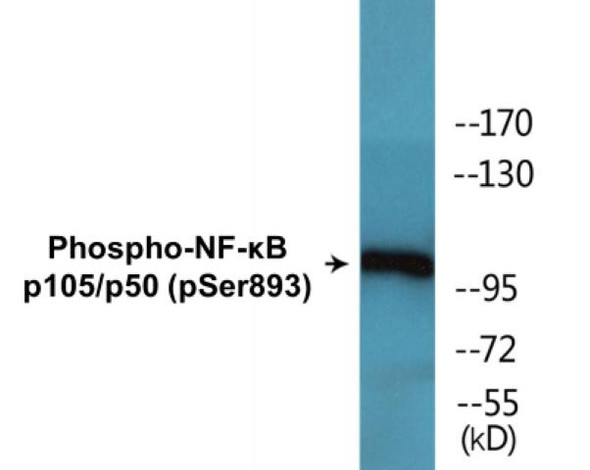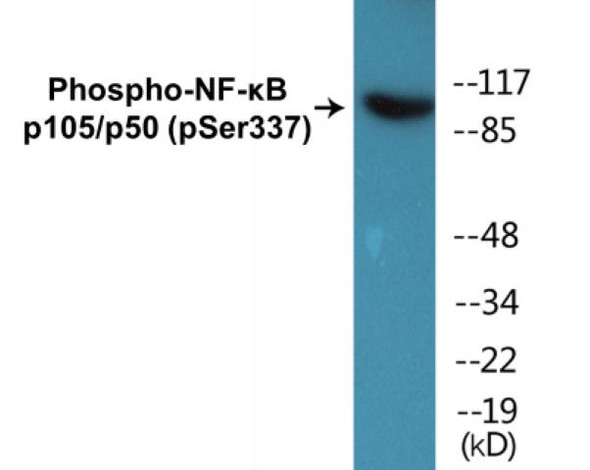Description
NF-kappaB p105/p50 Colorimetric Cell-Based ELISA Kit
The NF-kappaB p105/p50 Colorimetric Cell-Based ELISA Kit is specifically designed for the accurate detection of NF-kappaB p105/p50 levels in cell lysates and tissue homogenates. This kit offers high sensitivity and specificity, ensuring precise and consistent results, making it ideal for various research applications.NF-kappaB p105/p50 is a key transcription factor involved in regulating immune and inflammatory responses. Dysregulation of NF-kappaB signaling has been implicated in a wide range of diseases, including cancer, autoimmune disorders, and chronic inflammatory conditions.
The NF-kappaB p105/p50 Colorimetric Cell-Based ELISA Kit provides researchers with a valuable tool for studying NF-kappaB signaling pathways and developing potential therapeutic interventions.Overall, this kit provides researchers with a reliable and efficient method for quantifying NF-kappaB p105/p50 levels, contributing to a better understanding of its role in disease pathogenesis and potential therapeutic strategies.
| Product Name: | NF-kappaB p105/p50 Colorimetric Cell-Based ELISA Kit |
| Product Code: | CBCAB00780 |
| ELISA Type: | Cell-Based |
| Target: | NF-kappaB p105/p50 |
| Reactivity: | Human, Mouse |
| Dynamic Range: | > 5000 Cells |
| Detection Method: | Colorimetric 450 nmStorage/Stability:4°C/6 Months |
| Format: | 96-Well Microplate |
The NF-kappaB p105/p50 Colorimetric Cell-Based ELISA Kit is a convenient, lysate-free, high throughput and sensitive assay kit that can detect NF-kappaB p105/p50 protein expression profile in cells. The kit can be used for measuring the relative amounts of NF-kappaB p105/p50 in cultured cells as well as screening for the effects that various treatments, inhibitors (ie siRNA or chemicals), or activators have on NF-kappaB p105/p50.
Qualitative determination of NF-kappaB p105/p50 concentration is achieved by an indirect ELISA format. In essence, NF-kappaB p105/p50 is captured by NF-kappaB p105/p50-specific primary antibodies while the HRP-conjugated secondary antibodies bind the Fc region of the primary antibody. Through this binding, the HRP enzyme conjugated to the secondary antibody can catalyze a colorimetric reaction upon substrate addition. Due to the qualitative nature of the Cell-Based ELISA, multiple normalization methods are needed:
| 1. | A monoclonal antibody specific for human GAPDH is included to serve as an internal positive control in normalizing the target absorbance values. |
| 2. | Following the colorimetric measurement of HRP activity via substrate addition, the Crystal Violet whole-cell staining method may be used to determine cell density. After staining, the results can be analysed by normalizing the absorbance values to cell amounts, by which the plating difference can be adjusted. |
| Database Information: | Gene ID: 4790, UniProt ID: P19838, OMIM: 164011, Unigene: Hs.618430 |
| Gene Symbol: | NFKB1 |
| Sub Type: | None |
| UniProt Protein Function: | NFkB-p105: a transcription factor of the nuclear factor-kappaB ( NFkB) group. Undergoes cotranslational processing by the 26S proteasome to produce a 50 kD protein. The 105 kD protein is a Rel protein-specific transcription inhibitor and the 50 kD protein is a DNA binding subunit of NFkB. NFkB is a transcription regulator that is activated by various intra- and extra-cellular stimuli such as cytokines, oxidant-free radicals, ultraviolet irradiation, and bacterial or viral products. Activated NFkB translocates into the nucleus and stimulates the expression of genes involved in a wide variety of biological functions. Inappropriate activation of NFkB has been associated with a number of inflammatory diseases while persistent inhibition of NFkB leads to inappropriate immune cell development or delayed cell growth. There are five NFkB proteins in mammals (RelA/NFkB-p65, RelB, c-Rel, NF-_B1/NFkB-p105, and NF-_B2/NFkB-p100). They form a variety of homodimers and heterodimers, each of which activates its own characteristic set of genes. Two alternatively spliced isoforms have been described. |
| UniProt Protein Details: | Protein type:DNA-binding; Transcription factor Chromosomal Location of Human Ortholog: 4q24 Cellular Component: cytoplasm; cytosol; mitochondrion; neuron projection; nucleoplasm; nucleus Molecular Function:actinin binding; chromatin binding; heat shock protein binding; identical protein binding; protein binding; protein heterodimerization activity; protein homodimerization activity; transcription factor activity; transcription factor binding Biological Process: activation of NF-kappaB transcription factor; apoptosis; I-kappaB kinase/NF-kappaB cascade; inflammatory response; innate immune response; membrane protein intracellular domain proteolysis; MyD88-dependent toll-like receptor signaling pathway; MyD88-independent toll-like receptor signaling pathway; negative regulation of apoptosis; negative regulation of cellular protein metabolic process; negative regulation of cholesterol transport; negative regulation of inflammatory response; negative regulation of interleukin-12 biosynthetic process; negative regulation of transcription from RNA polymerase II promoter; nerve growth factor receptor signaling pathway; positive regulation of interferon type I production; positive regulation of transcription from RNA polymerase II promoter; positive regulation of transcription, DNA-dependent; response to copper ion; response to oxidative stress; stimulatory C-type lectin receptor signaling pathway; stress-activated MAPK cascade; T cell receptor signaling pathway; toll-like receptor 10 signaling pathway; toll-like receptor 2 signaling pathway; toll-like receptor 3 signaling pathway; toll-like receptor 4 signaling pathway; toll-like receptor 5 signaling pathway; toll-like receptor 9 signaling pathway; toll-like receptor signaling pathway; transcription from RNA polymerase II promoter Disease: Immunodeficiency, Common Variable, 12 |
| NCBI Summary: | This gene encodes a 105 kD protein which can undergo cotranslational processing by the 26S proteasome to produce a 50 kD protein. The 105 kD protein is a Rel protein-specific transcription inhibitor and the 50 kD protein is a DNA binding subunit of the NF-kappa-B (NFKB) protein complex. NFKB is a transcription regulator that is activated by various intra- and extra-cellular stimuli such as cytokines, oxidant-free radicals, ultraviolet irradiation, and bacterial or viral products. Activated NFKB translocates into the nucleus and stimulates the expression of genes involved in a wide variety of biological functions. Inappropriate activation of NFKB has been associated with a number of inflammatory diseases while persistent inhibition of NFKB leads to inappropriate immune cell development or delayed cell growth. Alternative splicing results in multiple transcript variants encoding different isoforms, at least one of which is proteolytically processed. [provided by RefSeq, Feb 2016] |
| UniProt Code: | P19838 |
| NCBI GenInfo Identifier: | 21542418 |
| NCBI Gene ID: | 4790 |
| NCBI Accession: | P19838.2 |
| UniProt Secondary Accession: | P19838,Q68D84, Q86V43, Q8N4X7, Q9NZC0, A8K5Y5, B3KVE8 |
| UniProt Related Accession: | P19838 |
| Molecular Weight: | 85,520 Da |
| NCBI Full Name: | Nuclear factor NF-kappa-B p105 subunit |
| NCBI Synonym Full Names: | nuclear factor of kappa light polypeptide gene enhancer in B-cells 1 |
| NCBI Official Symbol: | NFKB1 |
| NCBI Official Synonym Symbols: | p50; KBF1; p105; EBP-1; CVID12; NF-kB1; NFKB-p50; NFkappaB; NF-kappaB; NFKB-p105; NF-kappa-B |
| NCBI Protein Information: | nuclear factor NF-kappa-B p105 subunit |
| UniProt Protein Name: | Nuclear factor NF-kappa-B p105 subunit |
| UniProt Synonym Protein Names: | DNA-binding factor KBF1; EBP-1; Nuclear factor of kappa light polypeptide gene enhancer in B-cells 1 |
| UniProt Gene Name: | NFKB1 |
| UniProt Entry Name: | NFKB1_HUMAN |
| Component | Quantity |
| 96-Well Cell Culture Clear-Bottom Microplate | 2 plates |
| 10X TBS | 24 mL |
| Quenching Buffer | 24 mL |
| Blocking Buffer | 50 mL |
| 15X Wash Buffer | 50 mL |
| Primary Antibody Diluent | 12 mL |
| 100x Anti-Phospho Target Antibody | 60 µL |
| 100x Anti-Target Antibody | 60 µL |
| Anti-GAPDH Antibody | 60 µL |
| HRP-Conjugated Anti-Rabbit IgG Antibody | 12 mL |
| HRP-Conjugated Anti-Mouse IgG Antibody | 12 mL |
| SDS Solution | 12 mL |
| Stop Solution | 24 mL |
| Ready-to-Use Substrate | 12 mL |
| Crystal Violet Solution | 12 mL |
| Adhesive Plate Seals | 2 seals |
The following materials and/or equipment are NOT provided in this kit but are necessary to successfully conduct the experiment:
- Microplate reader able to measure absorbance at 450 nm and/or 595 nm for Crystal Violet Cell Staining (Optional)
- Micropipettes with capability of measuring volumes ranging from 1 µL to 1 ml
- 37% formaldehyde (Sigma Cat# F-8775) or formaldehyde from other sources
- Squirt bottle, manifold dispenser, multichannel pipette reservoir or automated microplate washer
- Graph paper or computer software capable of generating or displaying logarithmic functions
- Absorbent papers or vacuum aspirator
- Test tubes or microfuge tubes capable of storing ≥1 ml
- Poly-L-Lysine (Sigma Cat# P4832 for suspension cells)
- Orbital shaker (optional)
- Deionized or sterile water
*Note: Protocols are specific to each batch/lot. For the correct instructions please follow the protocol included in your kit.
| Step | Procedure |
| 1. | Seed 200 µL of 20,000 adherent cells in culture medium in each well of a 96-well plate. The plates included in the kit are sterile and treated for cell culture. For suspension cells and loosely attached cells, coat the plates with 100 µL of 10 µg/ml Poly-L-Lysine (not included) to each well of a 96-well plate for 30 minutes at 37°C prior to adding cells. |
| 2. | Incubate the cells for overnight at 37°C, 5% CO2. |
| 3. | Treat the cells as desired. |
| 4. | Remove the cell culture medium and rinse with 200 µL of 1x TBS, twice. |
| 5. | Fix the cells by incubating with 100 µL of Fixing Solution for 20 minutes at room temperature. The 4% formaldehyde is used for adherent cells and 8% formaldehyde is used for suspension cells and loosely attached cells. |
| 6. | Remove the Fixing Solution and wash the plate 3 times with 200 µL 1x Wash Buffer for five minutes each time with gentle shaking on the orbital shaker. The plate can be stored at 4°C for a week. |
| 7. | Add 100 µL of Quenching Buffer and incubate for 20 minutes at room temperature. |
| 8. | Wash the plate 3 times with 1x Wash Buffer for 5 minutes each time. |
| 9. | Add 200 µL of Blocking Buffer and incubate for 1 hour at room temperature. |
| 10. | Wash 3 times with 200 µL of 1x Wash Buffer for 5 minutes each time. |
| 11. | Add 50 µL of 1x primary antibodies (Anti-NF-kappaB p105/p50 Antibody and/or Anti-GAPDH Antibody) to the corresponding wells, cover with Parafilm and incubate for 16 hours (overnight) at 4°C. If the target expression is known to be high, incubate for 2 hours at room temperature. |
| 12. | Wash 3 times with 200 µL of 1x Wash Buffer for 5 minutes each time. |
| 13. | Add 50 µL of 1x secondary antibodies (HRP-Conjugated AntiRabbit IgG Antibody or HRP-Conjugated Anti-Mouse IgG Antibody) to corresponding wells and incubate for 1.5 hours at room temperature. |
| 14. | Wash 3 times with 200 µL of 1x Wash Buffer for 5 minutes each time. |
| 15. | Add 50 µL of Ready-to-Use Substrate to each well and incubate for 30 minutes at room temperature in the dark. |
| 16. | Add 50 µL of Stop Solution to each well and read OD at 450 nm immediately using the microplate reader. |
(Additional Crystal Violet staining may be performed if desired – details of this may be found in the kit technical manual.)






